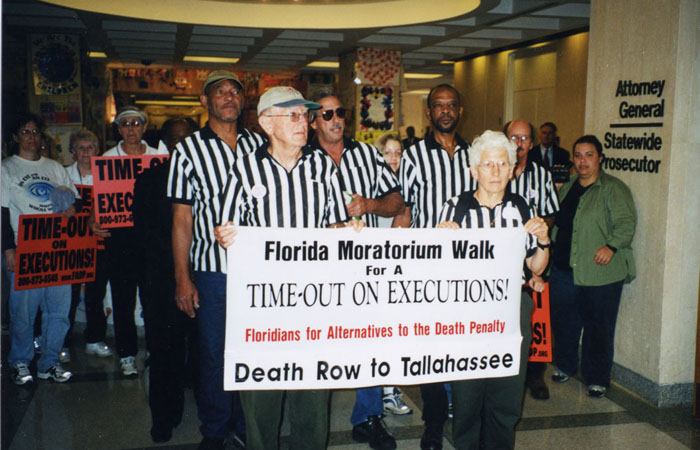Collections : [National Death Penalty Archive]
National Death Penalty Archive
Researchers, writers, activists, and records on capital punishment in the United States.
Search Constraints
Start Over You searched for: Collecting Area National Death Penalty Archive Remove constraint Collecting Area: National Death Penalty Archive Date range 1960 to 1969 Remove constraint Date range: <span class="from" data-blrl-begin="1960">1960</span> to <span class="to" data-blrl-end="1969">1969</span>Search Results
David Von Drehle Papers, 1897-2003 7.5 cubic ft.
Alvin Ford Papers, 1965-1995 5.4 cubic ft.
Bill Babbitt Collection, 1967-2016 4.82 cubic ft.
Manny Babbitt, 1967-1999, Undated 1.83 cubic ft.
The series consists of the contents of Manny Babbitt's cell at the time of his execution in May 1999, materials relating to his time in San Quentin, and documents about his Marine Corps service. This series contains Manny Babbitt's original works, including several poems. There also is an empty cardboard box which housed Manny Babbitt's personal items in his cell. Please note that the dates for the series are not inclusive and the bulk of files date from the 1990s.
Bill Pelke Papers, 1965-2007, Undated 18.32 cubic feet
Correspondence, 1967-1999, Undated 1.6 cubic feet
This series contains the correspondence directed to Bill Pelke, as well as a small amount of correspondence from Bill Pelke. This includes correspondence from death row inmates and fellow activists. Correspondence from activist groups is included in the Activism series; however researchers should note that because of the nature of activist groups, one individual may be involved in many groups. In the event of one individual with correspondence from many groups the correspondence has been assembled together under the activists name.
Biographical, 1950-1998 0.17 cubic ft.
This series contains two large bibliographies of Ernest van den Haag's writings. The first bibliography covers his works from 1950-1982. The second includes his writings up to 1998. These bibliographies organize his writings alphabetically by topic and each publication includes an assigned number. These numbers do not reflect a strict, but rather general chronological order (i.e. number one was published in 1968 while number two was published in 1954). The numbering system probably reflects the order in which the articles were begun. Some were published quickly while others took longer. This series also contains van den Haag's curriculum vitae from 1973-1998 as well as short biographies from 1973-1989.
Ernest Van Den Haag Papers, 1935-2000 11.45 cubic ft.
This series consists of correspondence, meeting minutes of the Board of Directors (1977-1985) and the Executive Committee (1971-1973, 1984), and committee files created or gathered by the executive director, chairman, president, general secretary, and committee chairs of the Association. It also contains biographical information about prospective board members gathered by the Nominating Committee (1963-1967, 1969, 1971-1972, 1974-1982, 1984). Other documents in the series include meeting agendas, memoranda, grant proposals, reports, membership statistics, and records concerning bequests and endowments made to the Association. This material concerns prison conditions, children of offenders, sentencing policies, court rulings concerning prisoners' efforts to form labor unions, construction of new correctional facilities, and the operations of the Association itself. Letters from inmates concerning living conditions in various correctional facilities, transfers from one facility to another, health issues, allegations of abuse by corrections officers, and post-release work arrangements and drug-rehabilitation programs are scattered throughout the series. One of the letters (1985) directed to Correctional Association President Robert Gangi was written by Jean Harris, who became interested in the special problems of female inmates and their children during her imprisonment for murder. Note that the files created by the Institution's Visiting Committee are housed in Series 3, Prison Visits Files, circa 1915-1985, and files created by the Narcotics Committee are housed in Series 4, Narcotics Committee Files, 1949-1975.
Correctional Association of New York Records, 1844-1988 30.97 cubic ft.
Contains items housed in oversized materials folder.
Capital Jury Project, 1941-2011 81.8 cubic ft.
Card File Index of Executions, Undated 2.8 cubic ft.
Watt Espy kept a series of index cards, grouped mainly by state, that records information about executions on American soil (colonies, states, territories) since the 1600s. Some cards contain lots of information, including name, place of execution, method, and details of the crime. Other cards have very little information aside from the fact that someone was executed. Sometimes there is not even a name—just "two slaves" or "pirate". There are additional categories for federal, military, and indigenous executions. There are two different card sizes; for the 3x5 inch cards, each state, territory, or other main division is identified with a manila tab. Subdivisions are marked with blue, unlined cards and are intended to mirror the arrangement of materials in Series #2 as closely as possible.
M. Watt Espy Papers, 1730-2008 88.76 cubic ft.
Case Files, 1947-2012, Undated 19 cubic ft.
This series contains a file for every execution or sentence of death given to a woman or a juvenile that was known to Victor L. Streib. Some of the case study files are simply photocopies of Watt Espy's research cards, especially in cases where Espy's research is the sum total information available that particular execution. Many of these cards are from before 1976, when the death penalty was re-instated in America. Due to improved record-keeping in the modern era, case files from recent years, especially ones that Streib advised in some capacity, may contain significantly more information than others. Information pertinent to these cases vary greatly by individual depending on the state, the era, as well as media coverage of the case. The research collection is up-to-date as of 2012, so any executions, pardons, or reversals that went forward since that date will remain in the series they were in at the time these papers were acquired by the archives.
Victor L. Streib Papers, 1908-2012, Undated, bulk 1978-2007 22.8 cubic ft.
- « Previous
- Next »
- 1
- 2
- 3
